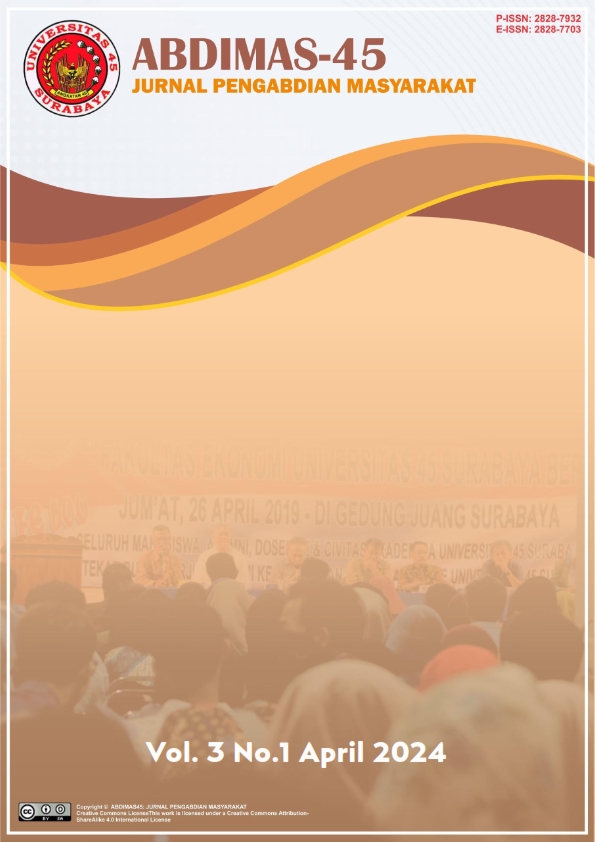Kegiatan Penapisan Pemeriksaan Kadar Asam Urat terhadap Hiperurisemia pada Populasi Lanjut Usia
DOI:
https://doi.org/10.30640/abdimas45.v3i1.2658Keywords:
Hyperuricemia, Uric Acid, Screening, ElderlyAbstract
Hyperuricemia, characterized by increased serum uric acid levels, occurs due to an imbalance between uric acid production and excretion. The prevalence in adults and the elderly in China is 12.69% and is higher in men (17.7%) than women (8.5%). Contributing factors such as genetics, diet, and lifestyle changes, lead to an increased risk of gout, kidney stones, and cardiovascular disease. Chronic hyperuricemia can cause joint damage and deformity due to the deposition of urate crystals. This activity uses the PDCA (Plan-Do-Check-Action) methodology to screen for hyperuricemia in the elderly at St. Mary's Church. Francis of Assisi. The screening results showed that 12 people (33.33%) of the 36 participants had hyperuricemia. Early detection of hyperuricemia is very important in preventing complications such as gout and cardiovascular disease. Regular check-ups and lifestyle changes can significantly improve health outcomes and quality of life for seniors.
References
Astuti, A., & Djuma, A. W. (2023). Health Status of Elderly Based on Daily Activities Living, Cholesterol and Uric Acid Profile in Kupang. Proceedings of the International Conference on Nursing and Health Sciences, 4(1), 105–112. https://doi.org/10.37287/picnhs.v4i1.1720
Chen, F., Yuan, L., Xu, T., Liu, J., & Han, S. (2022). Association of Hyperuricemia with 10-Year Atherosclerotic Cardiovascular Disease Risk among Chinese Adults and Elders. International Journal of Environmental Research and Public Health, 19(11), 6713. https://doi.org/10.3390/ijerph19116713
Ernawati, E., Adjie, E. K. K., Firmansyah, Y., Yogie, G. S., Setyanegara, W. G., & Kurniawan, J. (2023). Pengaruh Kadar Profil Lipid, Asam Urat, Indeks Massa Tubuh, Tekanan Darah, dan Kadar Gula Darah Terhadap Penurunan Kapasitas Vital Paru pada Pekerja Usia Produktif. Malahayati Nursing Journal, 5(8), 2679–2692. https://doi.org/10.33024/mnj.v5i8.10414
George, C., Leslie, S. W., & Minter, D. A. (2023). Hyperuricemia. Urology at a Glance, 107–109. https://doi.org/10.1007/978-3-642-54859-8_23
Ni, Q., Lu, X., Chen, C., Du, H., & Zhang, R. (2019). Risk factors for the development of hyperuricemia: A STROBE-compliant cross-sectional and longitudinal study. Medicine, 98(42), e17597. https://doi.org/10.1097/MD.0000000000017597
Nishizawa, H., Maeda, N., & Shimomura, I. (2022). Impact of hyperuricemia on chronic kidney disease and atherosclerotic cardiovascular disease. Hypertension Research, 45(4), 635–640. https://doi.org/10.1038/s41440-021-00840-w
Shahin, L., Patel, K. M., Heydari, M. K., & Kesselman, M. M. (2021). Hyperuricemia and Cardiovascular Risk. Cureus, 13(5), e14855. https://doi.org/10.7759/cureus.14855
Skoczyńska, M., Chowaniec, M., Szymczak, A., Langner-Hetmańczuk, A., Maciążek-Chyra, B., & Wiland, P. (2020). Pathophysiology of hyperuricemia and its clinical significance - a narrative review. Reumatologia, 58(5), 312–323. https://doi.org/10.5114/reum.2020.100140
Widjaja, Y., Kurniawan, J., Marcella, A., & Firmansyah, Y. (2023). Kewaspadaan Penyakit Dementia Melalui Edukasi Gaya Hidup Dan Skrining Albuminuria, Low-Density Lipoprotein (Ldl), Serta Asam Urat. SEWAGATI: Jurnal Pengabdian Masyarakat Indonesia, 2(2), 24–36. https://doi.org/10.56910/SEWAGATI.V2I2.640
Yokose, C., McCormick, N., & Choi, H. K. (2021). The role of diet in hyperuricemia and gout. Current Opinion in Rheumatology, 33(2), 135–144. https://doi.org/10.1097/BOR.0000000000000779
Downloads
Published
How to Cite
Issue
Section
License
Copyright (c) 2024 Jurnal Pengabdian Masyarakat

This work is licensed under a Creative Commons Attribution-ShareAlike 4.0 International License.








